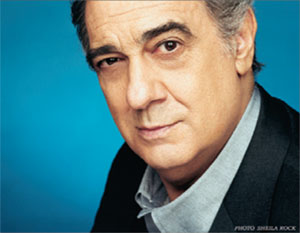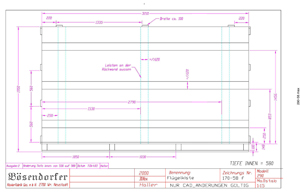Home Page ![]() Audio & Video Files
Audio & Video Files ![]() CEUS
CEUS ![]() Image Gallery
Image Gallery ![]() Interesting Articles
Interesting Articles ![]() Links
Links ![]()

Crafting the Imperial Piano
|
|

|
S/N 44606
I have a sense that this piano was built with some extra special pride (and the usual care) since it is the first Imperial piano made like this. Imperial instruments made before S/N 44606 were made in the traditional contemporary style and usually were finished with the black Ebony exterior although some were finished with other woods. The Model 290 (S/N 44606) featured on this site is unprecedented in that this was the first Imperial piano produced with Pyramid Mahogany wood and in the ornate fashion popular for pianos made in the late 19th Century by companies Bösendorfer; this piano represents the best of the past and present.
The elaborate design of this Model 290 instrument is similar to what were provided by Bösendorfer over the mid to late 19th century to: Frédéric Chopin (1 March 1810 - 17 October 1849), Franz Liszt (22 October 1811 - 31 July 1886) whose 187cm Bösendorfer SN 7561 that was played from 1880 until his death can be seen in the composers museum on line at www.lisztmuseum.hu/eng/salon-2.html, Antonín Leopold Dvořák (8 September 1841 - 1 May 1904), and many other famous pianists and composers. At the Johann Strauss museum where he composed "Blue Danube Waltz" (Austria's unofficial national anthem) is his Bösendorfer Baby Grand piano in ebony; Ludwig Bösendorfer commissioned this piano and presented it to his friend in 1896. The Strauss piano bears the opus number 14102 ("Werknummer" 5025), and is Inv. No. 76710 in the collection of the WIEN Museum. Interestingly an 1840's Bösendorfer piano played by Liszt had been on tour across the USA and in the year 2000 it too was placed on public display alongside mine. Although the color tone of the finishes between the pianos differ somewhat, the Mahogany's Pyramid-like grain of the Liszt piano is the same as that of my piano so that when S/N 44606 and the original Liszt are set side by side they match in grain.
the great Ludwig Bösendorfer, with pleasant memories" Johann Strauss 1897
L. Bösendorfer GmbH offers these design features as a special order option "Johann Strauss" Model. These are a combination of elements taken from different periods in history and they are reflected in the beautifully carved legs of the Piano and the matching Artist Bench, the ornamental fretwork of the music desk and the decorated inner side of the fallboard. The inner rim is finished in striking Maple wood, and the pedal Lyre is created in the shape of the instrument of the classic Greek period bending the bow to the beginnings of the occidental music culture and the manufacturing of musical instruments in which Bösendorfer plays such an important role. In order to maintain the sense of proportion for the legs, the caster wheels of this Imperial piano are smaller than those of the contemporary Imperial piano, such that these more readily leave their mark on even the best hardwood floor.
The Pyramid mahogany wood is harvested from controlled, licensed forests in West Africa. The rough "pyramid" sections are sawn from suitable forks in the trees so the veneers made from this wood are beautiful due to the unique smooth cut and the remarkable and decorative pyramid design that reflects light from deep within the grain. The initially light red to reddish-brown color darkens with time to the typically warm mahogany tones with a golden shimmer. All of this combines to assure each instrument is unique and distinguishable from any other that might be made of similar wood.
The Bösendorfer logo in gold is on the side of the instrument and is also centered on the Fall Board (visible when open) as are typical of the production instruments. However, the Bösendorfer logo on the Fall Board is flanked by gold scroll work and to either side of the logo and scroll are the Austrian doubleheaded Eagle Coat of Arms of the late 19th century Habsburg Monarchy Empire, this is also in gold. While the eagles on this Imperial piano are similar to those on the Strauss piano shown below, one family member was rather shocked when at first glance they confused these Austrian eagles with those of the Nazi Third Reich!
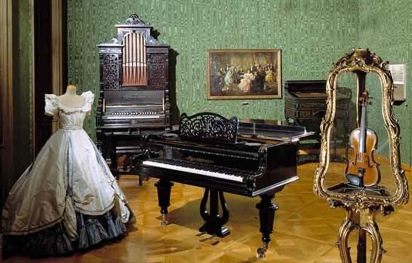
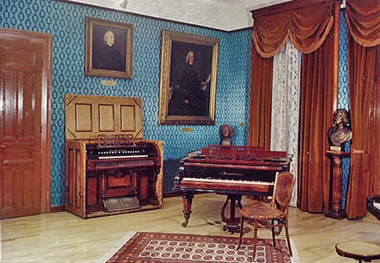
Top left is the ebony Bösendorfer No. 14102 of Johann Strauss in the Salon of the WIEN MUSEUM Johann Strauss Wohnung (residence) at Praterstraße 54, 1020 Vienna.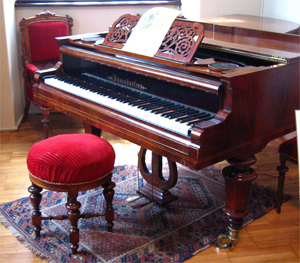
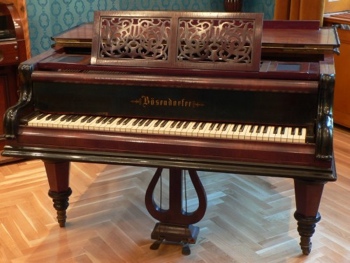
Above are some of S/N 44606's ancestors:
Top right is the mahogany 1873 Bösendorfer No. 7561 of Franz Liszt displayed in Salon 2 of the Liszt Ferenc Memorial Museum in Budapest, Hungary. Below is close up view.
And lower left is the mahogany 1879 Bösendorfer of Antonín Leopold Dvořák at the Antonín Dvořák Museum of villa America in Prague, Czech Republic.
Click on either image to see an enlarged view
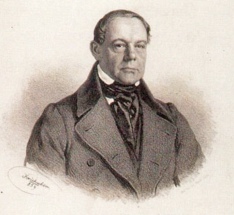 Ignaz Bösendorfer was born in Vienna (Wein) on 28 July 1796 just as the Archduchy of Austria, one of the most important states within the Holy Roman Empire, was undergoing dramatic changes. By this time Vienna had already been established as the centre of the musical world influenced by the music of Mozart, Beethoven and Schubert all who lived during his lifetime.
Ignaz Bösendorfer was born in Vienna (Wein) on 28 July 1796 just as the Archduchy of Austria, one of the most important states within the Holy Roman Empire, was undergoing dramatic changes. By this time Vienna had already been established as the centre of the musical world influenced by the music of Mozart, Beethoven and Schubert all who lived during his lifetime.
Left: Ignaz Bösendorfer (1796-1859). Lithograph in 1859 by Josef Kriehuber (1800-1876).
From the archives of the Austrian National Library, Vienna.
Click on image to see enlarged view.
Bösendorfer grew up and prospered in a Vienna that remained the center of the Habsburg Monarchy and later the capital of the Austrian Empire. He was the son of a master carpenter and in time he studied at the Academy of Fine Arts, a school well regarded for its education of painters, sculptors and architects. Ignaz gradually became respected for his musicality and technical competence, and as such in 1815 was sent to the work for the well-known piano builder Joseph Brodmann (b. 1763, d. 13 May 1848).
Brodmann began his career in the carpentry trade then in 1783 came to Vienna to work as an apprentice of the well known piano builder Frederick Hoffmann. So Ignaz would represent at least a third generation of experienced craftsmen making pianos and organs. Working for the Brodmann company since age 19 he learned about the trade and about it's business aspects. After more than a dozen years working there, with 500 Gulden Ignaz acquired Brodmann's workshops and the Bösendorfer piano company was established on 25 July 1828.
Under Ignaz leadership the company developed many innovations that put the Bösendorfer name on the world map of of musical instruments makers and later on the forefront of piano technology. Pianists who came to reply on his pianos included Johannes Brahms, Anton Bruckner, Franz Liszt, Anton Rubinstein and Hans von Bülows. Bösendorfer became a benefactor of new and coming talent, and pianists become friends and customers of Bösendorfer. By the mid 1800's the company had outgrown its original location and construction of a new facility in Vienna commenced. But Ignaz would not live to see it completed as he died on 14 April 1859 in Vienna.
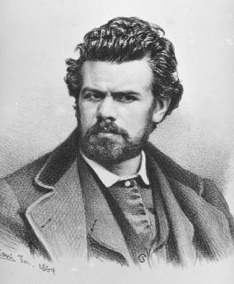 Ignaz son Ludwig Bösendorfer was born on 28 July 1835 in Vienna. Ludwig came to work for his father after studying from 1850 to 1852 at the Imperial-Royal Polytechnic Institute (now Wiener Polytechnischen Institut), one of the major universities in Vienna. After the death of his father in 1859 Ludwig headed the operations just as the new Schottentor factory came on line. Notable improvements to piano technology continued to be developed including in 1859 the design of improved piano action mechanism that permitted a higher speed of the hammer head. Bösendorfer introduced the cast iron frame and overstrung scale (cross-stringing) that contribute significantly to the brilliant and yet supple Bösendorfer sound. By 1866 Ludwig was earning the formal appreciation of the monarchy with titles including Supplier of the Court (Hoflieferantentitel). The Bösendorfer pianos earned high acclaim at World Fairs, and soon the Russian Tsar and the Japanese Emperor Meiji owned Bösendorfer pianos.
Ignaz son Ludwig Bösendorfer was born on 28 July 1835 in Vienna. Ludwig came to work for his father after studying from 1850 to 1852 at the Imperial-Royal Polytechnic Institute (now Wiener Polytechnischen Institut), one of the major universities in Vienna. After the death of his father in 1859 Ludwig headed the operations just as the new Schottentor factory came on line. Notable improvements to piano technology continued to be developed including in 1859 the design of improved piano action mechanism that permitted a higher speed of the hammer head. Bösendorfer introduced the cast iron frame and overstrung scale (cross-stringing) that contribute significantly to the brilliant and yet supple Bösendorfer sound. By 1866 Ludwig was earning the formal appreciation of the monarchy with titles including Supplier of the Court (Hoflieferantentitel). The Bösendorfer pianos earned high acclaim at World Fairs, and soon the Russian Tsar and the Japanese Emperor Meiji owned Bösendorfer pianos.
Right: Ludwig Bösendorfer (1835-1919). Lithograph in 1864 by József Marastoni (1834-1895).
From the archives of the Austrian National Library, Vienna.
Click on image to see enlarged view.
In 1870 Bösendorfer expanded to even larger production facilities that remain as current headquarters at Graf Starhemberg Gasse 14 in Vienna. In 1872 a concert by Hans von Bülow inaugurated the original "Bösendorfer Hall" a concert hall that became famous for its excellent acoustics that would be visited by many famous artists until it was demolished in 1913. In 1889 the first winner of the Bösendorfer Piano Competition was awarded a premium piano, a traditional competition that continues to this day!
Ignaz became acquainted with an even larger circle of world class pianists and conductors including Anton Bruckner, Johann Strauss, Richard Strauss, Arnold Schoenberg, and Gustav Mahler. But it was composer and pianist Ferruccio Busoni who suggested Bösendorfer develop what would become the Imperial Bösendorfer piano.
-
The Model 290 Piano Developed
Right: Ferruccio Busoni, b. 1866 d. 1924. Image courtesy Library of Congress (image 58,046 bytes).
The extended range enables the performance of some compositions originally scored for the Organ by composers including Bach, Bartók, Debussy, and Ravel. For example Busoni's Piano Concerto in C major, Opus 39* of 1904 was written to be accurately performed only on the Imperial piano.
* I recommend you listen to this piano concerto performed on a Bösendorfer Imperial piano on the CD Busoni Piano Concerto recorded 4 February 1989 by Garrick Ohlsson with the Cleveland Orchestra and Mens Chorus. This is Telarc CD-80207. The music is beautifully written, brilliantly played by Ohlsson, and with the orchestra and Men's Chorus conducted by Christoph von Dohnanyi they (with Telarc engineers) may have accomplished the best recorded performance of this Concerto. The third movement in particular really shows off the commanding tones of the piano's bass register. However, as well done as is this performance I counsel no audio or computer system can truly reproduce the moving experience of listening live in the presence of an Imperial.
Click on image to see enlarged view (110,502 bytes).
Ludwig Bösendorfer married twice but had no children. So at age 74 in 1909, Bösendorfer sold the company Karl Hutterstrasser, a Viennese banker. The changing face of Vienna impacted Ignaz, and the outbreak of "The War To End All Wars" disheartened him further. On 9 May 1919 Ludwig Bösendorfer died in Vienna.
The intent of this site is not to provide a concise history of the company, but to put into context the establishment of the company and the development of the Imperial Model 290 instruments. For more information about the recent history of the company as I came to know it please refer to my discussion about recent history at L. Bösendorfer Klavierfabrik GmbH on my links page.
|

|
|
Contact the owner of this piano.
|
Contents © 2000-2010 Martin Cohen and Respective Contributors, All Rights Reserved |
